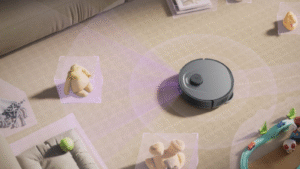Robot vacuums have become an essential part of modern homes, making cleaning faster, easier, and more efficient. Today’s vacuum robots, particularly models like the best robot vacuum for hardwood floors, can navigate around furniture, avoid common obstacles, and clean multiple surfaces with minimal human effort. They are designed to handle dust, dirt, and pet hair efficiently while protecting delicate flooring. However, one limitation remains: most robot vacuums cannot detect hazardous materials such as chemical spills, broken glass, or sharp objects. These hazards can reduce cleaning effectiveness, damage floors, or even pose a safety risk. As technology evolves, the next generation of robot vacuum may be capable of identifying these dangers and taking action to avoid them automatically, providing both a cleaner and safer home environment.
Current Capabilities of Robot Vacuums
Most modern vacuum robot rely on sensors such as LIDAR, infrared, and cameras for navigation. These systems allow the robots to map rooms, detect obstacles, and follow efficient cleaning paths. High-end models like the best robot vacuum for hardwood floors can even adjust suction strength to protect delicate surfaces while maintaining thorough cleaning. Some robots are equipped with additional features like edge detection, cliff sensors, and adaptive mapping, which prevent collisions with furniture and accidental falls. Despite these capabilities, they still cannot recognize certain dangers, including small sharp objects, liquids, or hazardous chemicals. A spilled cleaning solution or a sharp fragment could easily interfere with the robot’s cleaning cycle or damage its internal components.
Emerging Technologies for Hazard Detection
Future robot vacuums could incorporate advanced sensors to detect potential hazards more accurately. Chemical sensors could help detect spills of cleaning products or other liquids, moisture sensors could identify water or other fluids, and micro-cameras combined with AI could recognize sharp or dangerous objects. Machine learning algorithms would allow these vacuum robots to learn patterns of hazards over time. For example, if a certain area frequently has small debris or spilled liquids, the robot could remember this location and adjust its cleaning path to avoid the risk. Real-time alerts sent to a smartphone could further allow homeowners to take immediate action, combining automation with user supervision.
Integrating Hazard Awareness into Robot Vacuum Design
To function safely, hazard-aware robot vacuums must balance cleaning efficiency with risk avoidance. Path-planning algorithms could prioritize avoiding hazardous zones while ensuring all other areas are thoroughly cleaned. For homes with hardwood floors, future robot vacuums could manage suction power, water flow for mopping, and hazard detection simultaneously, preventing damage to delicate surfaces. Multi-functional robots may also integrate disinfection features or UV-light sterilization while actively avoiding unsafe areas, making them more than cleaning devices—they become proactive household assistants.
Challenges and Future Outlook
Integrating hazard detection in robot vacuums comes with technical and economic challenges. Sensors must be sensitive and durable, software must handle complex real-world scenarios, and battery life must support additional processing without compromising cleaning time. Production costs and maintenance requirements may also rise. Despite these obstacles, the potential is significant. Future vacuum robots could prevent accidents, protect flooring, and maintain a cleaner, safer home environment, particularly for households with children, pets, or elderly residents.
The Next Frontier in Home Automation
The next generation of robot vacuums promises to go beyond simple cleaning. With advanced sensors, AI, and hazard detection, they could identify spills, sharp objects, and other risks, making homes cleaner and safer. For homeowners using the best robot vacuum for hardwood floors, these advancements mean a device that not only cleans effectively but also safeguards your living space. As technology continues to advance, vacuum robots will become smarter, safer, and more essential for modern home management, setting the stage for truly autonomous and intelligent cleaning solutions.









